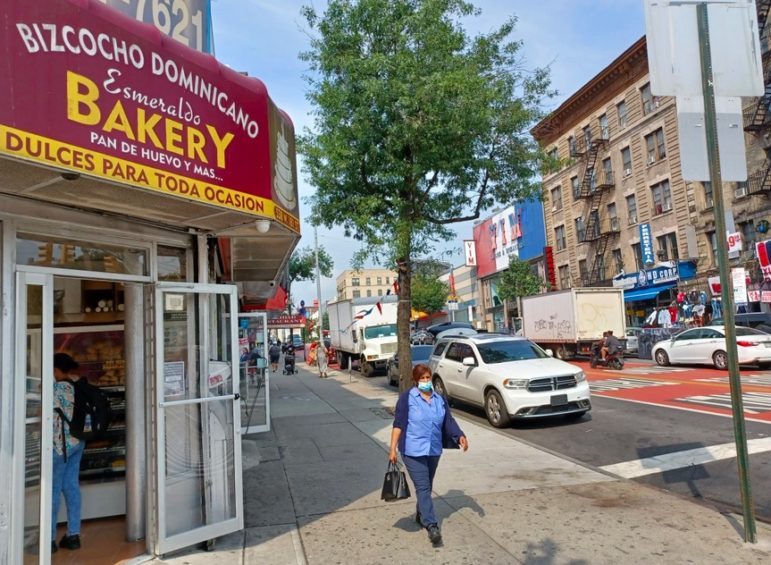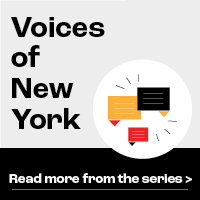More than 17,000 Hispanic residents left Washington Heights and Inwood between 2010 and 2020, while a total of 4,824 white residents moved into both neighborhoods during the same period, El Diario reports.

Fernando Martínez for El Diario
A Dominican bakery in Upper Manhattan.This story was originally published by El Diario on Sept. 18, 2021. It was translated for Voices of New York by Carlos Rodriguez, and has been lightly edited for clarity.
The results of the 2020 Census show two very clear trends regarding the presence of the largest Hispanic group in New York City. First, of the five boroughs’ 197 residential neighborhoods, Washington Heights and Inwood were the only ones to see a population reduction of 5 percent or more.
Second, while these areas are the epicenter of the city’s Dominican community, and on Google Maps appear under the nickname “Little Dominican Republic,” in the last 10 years they saw the arrival of new, mostly white, neighbors.
More than 17,000 Hispanic residents left Washington Heights and Inwood between 2010 and 2020, while a total of 4,824 white residents moved into both neighborhoods during the same period. The African-American population in the area remained relatively stable during the decade, showing a slight decrease.
The widespread interpretation of this population displacement trend is echoed almost unanimously by the Upper Manhattan area’s residents, who say rents have skyrocketed.
“Dominicans are moving to The Bronx, Philadelphia and Connecticut, scared off by the price of a tiny one-bedroom around here,” summarized Alberto Márquez, 48, who is Dominican.
In the 12 years he has lived there, he says he’s seen his neighbors opting to rent larger apartments or houses outside of Upper Manhattan for more reasonable prices.
“It has been a while now. Ever since I arrived here, I have heard people complain about how expensive Upper Manhattan was getting, and growing families leave because the spaces start to become too small for them. Then, the owners renovate the apartments, and a different type of people move in,” said the merchant, born in La Vega.
Márquez’s argument points at a familiar New York City debate, which urban planning experts call gentrification and which is seen especially in Manhattan and Brooklyn neighborhoods. It manifests itself through sharp increases in property prices and the subsequent displacement of poorer residents, who tend to be racial minorities, “whitening” the area’s demographic composition.
According to the census, Community District 12, which covers Washington Heights and Inwood, lost 9,800 residents between 2010 and 2020. It was one of the only two in New York City which had a significant population reduction.
“A tiny one-bedroom hole is now over $1,500 [per month]. Even a single room is renting for more than $200 a week,” said Rafael Rodríguez, who for 25 years has witnessed his fellow Dominican neighbors increasingly choosing to leave for The Bronx or farther away.
There are other opinions. Rent prices are not cited in other surveys as the sole cause of the Dominican exodus. As an example, 30-year-old Washington Heights native Lucía Figueredo, of Dominican descent, was raised on 182nd Street and St. Nicholas Avenue. Still, she left her “barrio” in the hope of finding “something larger and more comfortable.”
“I studied, got married, and was not displaced by poverty but because I started to get ahead,” said Figueredo. “I realized that I could pay the same for a larger space with a better environment for my children in a different state such as Pennsylvania. I am far away from my family. I miss the energy of my neighborhood every day. But you have to move forward.”
The legal professional deems it normal for people to want to change to find better opportunity, something her Caribbean ancestors know well.
Although the Dominican presence in New York dates back to the early 20th century, migration increased significantly after the 1960s, when thousands fled Rafael Trujillo’s regime. Figueredo’s grandparents were among them.
Some figures suggest that educational levels are linked to the demographic changes seen in New York City’s Dominican enclave, as people seek better opportunities.
A study from the City University of New York’s Center for Latin American, Caribbean and Latino Studies, spanning from 1990 and 2015, revealed that the educational level of Latinos in Washington Heights and Inwood progressed notably over that 25-year period.
“High school non-completion rates are down 25% from 1990, and the rate of individuals graduating with a four-year college degree has doubled, from 7% in 1990 to 14% in 2015,” states the report.
Citing available population counts, the paper states that poorer Latino families were not being displaced from the community. However, some think that this has changed in the last few years, a belief the 2020 census appears to confirm, at least in numbers.
Activist and photographer Rafael De Los Santos, who has 31 years of experience with the Upper Manhattan community, thinks that while every city is submitted to constant change, the shift in his neighborhood has been quite “fast.”
“To live in both the new and the renovated buildings, you need an annual income of $90,000. Let’s remember that our community is basically working class, who have to make a great effort to barely make $45,000,” said De Los Santos.
The community leader pointed out that this is a complex issue that should be analyzed from different points of view. Still, from the many stories he says to know up-close, he concludes that the principal cause for this “new migration” is the unaffordable rents.
“There are, however, other indicators that bring some hope to our community, which continues to be the poorest and the one with the lowest income in the city: All reports state that the largest group of Hispanic origin graduating from universities are Dominicans.”
For his part, political leader Luis Rodríguez, from Dominican organization Alianza País, which has an office in New York, believes there is another reason for the displacement of Dominicans and working families in these neighborhoods.
“If we take a look at these streets, small businesses had also started to close due to the high rents. Even before the pandemic, we could see a graveyard of closed shops along St. Nicholas and Audubon avenues. That had a terrible effect on the families of our small business owners,” said Rodríguez.
Santo Domingo-born merchant José Germán Fuentes, 68, said that, in 2018, after owning a restaurant on Dyckman Street in Inwood for 20 years, he and most of his compatriots who had businesses on the same block had to close due to a sudden 300 percent rent increase.
“I am going to summarize this whole thing for you: When the landlords see that an area is coming up, they find a way to push you out. Then, they fix it up a bit or tear the whole thing down, and build a new building. It is a cycle that started years ago and that leaves the poor and small business owners out,” he said.
Although some call it displacement, Fuentes, who now lives in The Bronx, said that the causes go beyond rising rent prices.
“I know at least 50 people who left this area for other reasons, but I also know that some left because of the violence, which has increased considerably. They did not want their children to be influenced by gangs. Others grew old and decided to move to Florida to escape the cold weather. Others got ahead and moved to fancy parts of the city. There’s all kinds of cases,” he said.
Fuentes has his own theory about the white neighbors who have recently moved to the area: “Most of the landlords are Jewish and other white races, and their children are moving in. Others are professionals who went to Columbia or work in the large hospitals, so they seek to live here and they can afford it.”
The Upper Manhattan population’s dynamics have also led to increased political representation in the City Council and in Congress. This presence is unlikely to disappear in the short term, at least in the opinion of Dominican-born Councilman Ydanis Rodríguez, who represents District 10.
“The debt the City continues to have with affordable housing remains extremely high. Obviously, our poorest neighbors have been displaced, and we will continue to fight in favor of building new developments. However, there are also many professionals among the younger generations who have chosen to buy homes outside of New York, and that has an impact,” said Rodríguez.
The politician believes that his compatriots are still a majority in Upper Manhattan and that the demographic changes reported in the latest Census stem from a number of factors.
“Clearly, there is a gentrification process, but some sectors of the population are also moving up socially thanks to the access to education,” concluded Rodríguez.
What did the 2020 Census reveal?
- 11 percent population drop in the north of Washington Heights
- 16 percent population drop in the south of Washington Heights
- 49,059 was the total population identified as Hispanic in the Washington Heights area in the 2010 Census. In 2020, the figure had dropped to 43,832.
- 5,227 fewer Hispanics live in Washington Heights than 10 years earlier
- 27,952 Hispanic residents lived in Inwood in 2010. Today, the number is 24,951.
- 3,001 fewer Latinos live in Inwood, one of the other main Dominican enclaves in the Big Apple.
- 0.2 percent fewer Hispanics live in Manhattan. It is the only borough where the 2020 Census found a decrease in population.










5 thoughts on “Washington Heights and Inwood See Population Dip, Uptick in White Residents, 2020 Census Shows”
“Because most landlords are Jewish and other white races and their kids move in”. Really? How about that Yeshiva University is situated in the Heights and many students take apartments during their college years and decide to stay on?
Can’t believe you didn’t challenge that guys inflammatory comment.
Not to mention that Jews have been in the neighborhood for close to a century particularly during and after World War II and their arrival long predated the Dominicans. And unlike Irish, Greeks etc. they have REMAINED in the neighborhood particularly Bennet Avenue and points further west – ever since (albeit at smaller numbers than previously). Hardly displacing anyone.
The Hispanic middle-class and the white middle-class are generally leaving NY for the suburbs and other states. Maybe a lot of those identifying as white in the 2020 census were Hispanics, but no real way to determine that.
in most cases the invading gentry want to have some hint of who was there as a real estate selling point….. like naming an expensive restaurant ‘bodega’ etc… also, many of the landlords are also latino and as n other places are happy to sell their now overpriced holdings…. there is no such things as altruism in real estate transactions…. evicting your co-ethnic relatives is very tempting…
“Most of the landlords are Jewish and other white races”
Really? The author decided to include an anti-Semitic quote for what purpose? I do not know who these landlords are, but I am certain that the 5,000 new white residents that moved into Inwood/WH aren’t mostly children of all the white landlords.